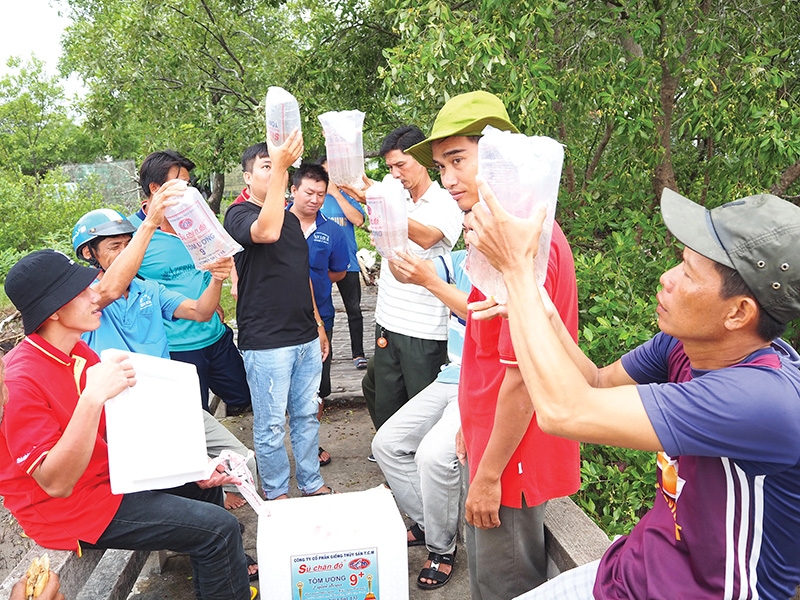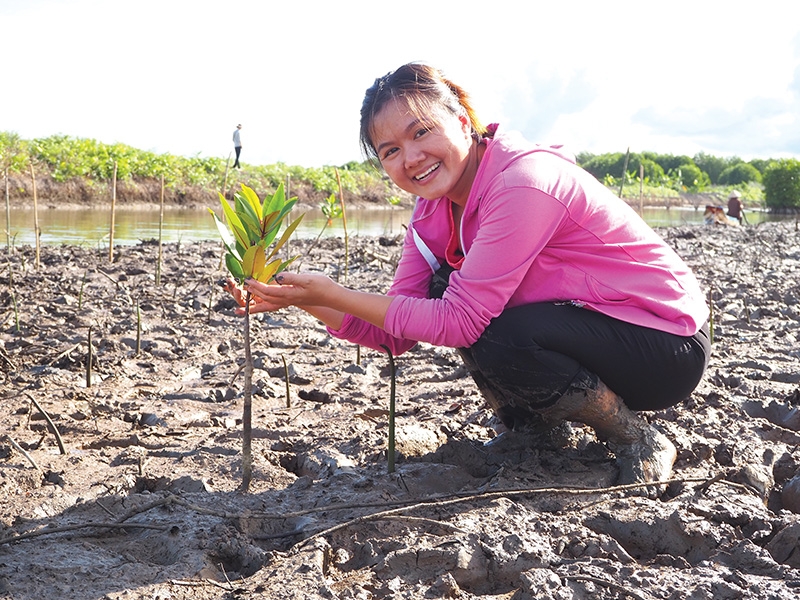Poorest areas offered helping hand with breeding initiative
 |
| The high-quality prawn breeds are enabling households to make more money than ever |
Having raised shrimp for 20 years, 50-year-old Phan Tien Ben calls Nguyen Viet Khai commune home – one of the poorest localities in the Mekong Delta region.
The commune, in Phu Tan district of the southernmost province of Ca Mau, faces the sea and difficult conditions for development as the majority of the inhabitants live on small-scale fishing activities, with an average annual income of VND40 million ($1,740) per household.
Ben’s family used to be as poor as many others, with an annual average income of VND30-35 million ($1,300-1,500), making it very hard for him to feed his family of four.
Under the severe impacts of climate change and natural disasters, Ca Mau is seeing its land shrinking, not only because of sea level rises and coastal erosion, but also due to the soil subsidence which was estimated at a reduction rate of three centimetres annually.
Figures from the provincial People’s Committee showed that in October, a major flood and storm raged in the province, drowning nearly 14,300 hectares of rice crops, 552ha of shrimp farms, and over 26ha of other crops, in addition to homes being smashed down in Dam Doi and Tran Van Thoi districts.
Since early this year, natural disasters in the province have destroyed fishing boats, left 11 people missing, smashed down over 800 houses, and sabotaged nearly 38,000ha of crops and 18,000ha of fishery farms. Besides that, more than 1,300 spots in rural roads were depressed, with a total length of 45 kilometres. Some 105km of coast line was also eroded.
A few months ago, the government provided VND70 billion ($3 million) for Ca Mau to cope with saline drought frequently attacking every year.
However, despite the serious aftermath of the natural disasters, the life of many households in Ca Mau has been improved. In fact, while Ben’s commune has a total of 3,078 households, only 69 of those households are now considered to be poor.
As the bread-winner, Ben runs a 5-ha shrimp farm in the commune, not far from his newly-built house. He has also recently bought a new big TV, a dream of the family. Over recent months, the family’s economic conditions have changed remarkably.
“Our annual average income has risen to VND50 million ($2,175), meaning we have become richer than before,” Ben told VIR with a smile. “So have many other households in the commune. Their livelihoods have been on the rise.”
 |
| Technical training is helping families in planting mangrove forests |
Game changer
So, what has led to such visible positive changes?
In October last year, many households including Ben’s in Nguyen Viet Khai commune, and Vien An Dong commune in Ngoc Hien district, were provided with black tiger prawn and crab breeds in a component backed by the Green Climate Fund (GCF). This component is part of a wider project to improve the resilience of coastal communities to climate change in Vietnam, funded jointly by the GCF, the Vietnamese government, and the United Nations Development Programme.
Under this component, known as regeneration of mangroves, each household like Ben’s were provided an average of 30,000 free-of-charge black tiger prawn breeds and 1,600 crab breeds (the number of breeds depending on the pond area), all of high quality, along with technical training as well.
“The breeds are big and easy to raise. After four months of farming, we can sell the prawns at a very high price, ranging from VND8,000 (35 US cents) up to as much as VND20,000 (87 US cents) for each,” Ben said. “Previously we often used low-quality and cheaper breeds bought in the local market, which made it difficult for us to earn high prices when selling.”
The products are sold to shrimp processors and exporters in the province. Like Ben, farmer Ngo Tuong Loi, 38, in Vien An Dong commune has also received the same amount of free items through the project just over a year ago, as well as technical support training.
Vien An Dong currently has 2,840 households with an average annual income of about VND60 million ($2,600) for each. About 60 of those households are classes as poor, with each earning an average annual income of VND30-35 million ($1,300-1,500).
However, Loi’s family now seems to be better off. “Previously we earned about VND150 million ($6,500) a year from shrimp farming. However, under the support of the Ca Mau GCF project, revenues have increased to VND200 million ($8,700),” Loi told VIR, revealing that his family has been able to purchase some expensive items including a refrigerator and a washing machine, previously deemed as out-of-reach luxuries.
After four months of raising, Loi’s prawns have been sold to Nam Can Seafood Import-Export JSC in Ca Mau’s Nam Can district. The company’s export markets include the likes of the US, Japan, Europe, South Korea, China, and the UAE.
Extending livelihoods
The GCF project has been providing the prawn and crab breeds free-of-charge for many other localities in Ca Mau. Last year, it handed out more than 5.5 million black tiger prawn breeds and 297,000 crab breeds for 176 households in Phu Tan and Ngoc Hien districts.
Earlier, the amount of such breeds was put out to tender by the Project Management Unit of Ca Mau province to select a reputable contractor with experience in high quality breeding. Through inspection, the quantity and quality are met, ensuring the conditions for rearing.
“The households were happy to receive the breeds from the project at the right time for farming season,” provincial project coordinator Pham Trung Thanh told VIR.
This year the GCF project has also provided prawn and crab breeds to 453 households in project areas (Phu Tan, Ngoc Hien, Dam Doi and Nam Can districts) with over 12.1 million black tiger prawn breeds and 741,200 crab breeds. This is the second year that this initiative has supported breeds for locals in the province with a view to helping gradually improving their living conditions.
Supporting local people with these breeds aims to ensure that temporary disruptions to livelihoods are addressed due to the relocation of communal aquaculture ponds impacted by plantations as part of the regeneration plan. The total funding comes to about $3 million from the GCF, and another $85,500 as counter-funding from the Vietnamese government, for the entire programme in Ca Mau.
Mangroves are a specific kind of forest in coastal areas. They are a special ecosystem with unique characteristics that are very different from other habitats in the area. Mangrove forests can protect people from natural disasters. Furthermore, mangroves have cultural and economic value and help to reduce the impacts of climate change.
According to Thanh, the project is now in good progress. As of late 2019, it supported the lives of 176 households in terms of raising shrimps and crabs and providing breeds, newly planted 109ha of mangrove forests, planted in supplementation another 645ha, and provided technical training on community-based disaster risk management skills for 13 coastal communes and towns.
This year, the project has been supporting 453 households, newly planting 49ha of mangrove forests, additionally planting another 474ha and protecting 1,389ha while providing technical training on community-based disaster risk management skills for five coastal communes.
As planned, it is expected that by the end of its lifespan, the project will have helped Ca Mau inhabitants plant and recover 3,224ha of mangrove forest, supported the livelihoods of about 1,000 households, and provided training on community-based disaster risk management for 38 coastal and near-coastal communes in the six districts of Dam Doi, Nam Can, Ngoc Hien, Phu Tan, Tran Van Thoi, and U Minh.
As these districts are the most vulnerable to natural disasters in Ca Mau, and if the project can be extended, it will surely continue benefiting farmers like Ben and Loi.
“We hope that after 2021, the project will be continued to benefit more people. Thanks to its training courses we now know how to select better breeds and protect farms during floods and storms,” Ben explained to VIR.
What the stars mean:
★ Poor ★ ★ Promising ★★★ Good ★★★★ Very good ★★★★★ Exceptional
Themes: Climate Change Response
Related Contents
Latest News
More News
- Heavy industries set for pilot greenhouse gas quotas (December 25, 2025 | 10:00)
- Swedfund invests in MSME growth and climate action in Vietnam (December 19, 2025 | 11:42)
- GreenYellow brings solar energy to light up remote schools in Tuyen Quang province (December 19, 2025 | 08:00)
- Charge+, Grab partner to develop EV charging network in Vietnam (December 18, 2025 | 17:11)
- Linking sci-tech and innovation to Vietnam’s net-zero future (December 18, 2025 | 14:31)
- Driving double-digit growth through green and circular transformation in Vietnam (December 17, 2025 | 09:00)
- Standard Chartered and ACCA deepen collaboration to develop Vietnam’s talent for a sustainable future (December 15, 2025 | 18:18)
- Schaeffler reports strong early output from Dong Nai solar project (December 12, 2025 | 15:16)
- Forestry conference highlights biodiversity and sustainability goals (December 09, 2025 | 13:35)
- Home Credit honoured among top 10 sustainable companies in trade and services (December 09, 2025 | 12:18)

 Tag:
Tag:





















 Mobile Version
Mobile Version